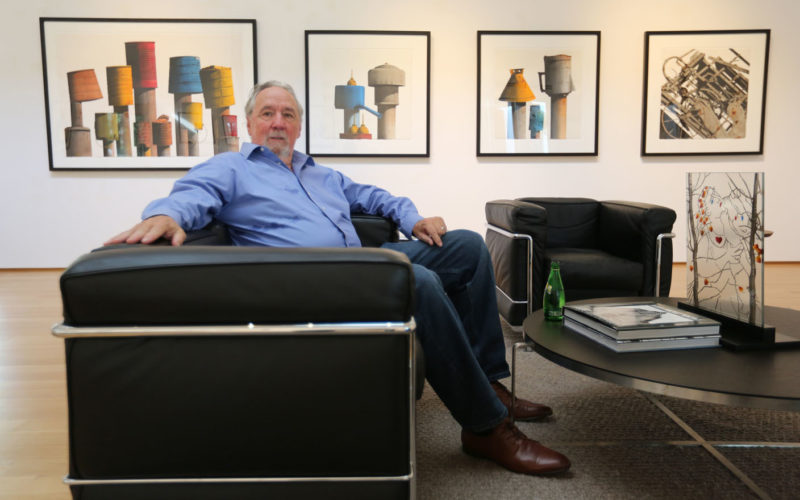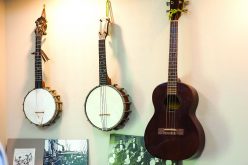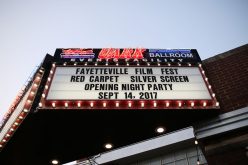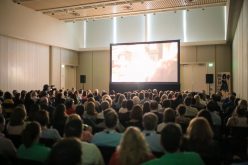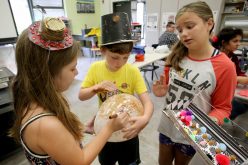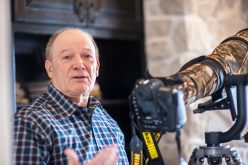Art galleries reflect, affect region
MARY JORDAN
mjordan@nwadg.com
Opinions differ on whether Northwest Arkansas has enough galleries and buyers to support a hoped-for growing arts scene.
No one’s measuring — at least publicly — how many galleries are here, what type of art they exhibit, how many artists call the region home, or the value of sales.
The Walton Family Foundation has paid for several initiatives to encourage a more creative economy in the area. The effort includes $439,500 in grants and professional development services over three years for 60 artists through a program called Artists 360.
A study commissioned by the foundation found a large increase from 2014 to 2018 in places where art is made in the region. The study included museums, music venues, restaurants and shops so it’s unknown if a growth in galleries occurred.
This year’s Art Market report by Art Basel and Union Bank of Switzerland reported an 86% decrease in the opening of art galleries since 2008. The report measured galleries exhibiting at at least one major art fair.
Becoming a successful working artist is challenging, and galleries are often the means by which many artists are able to make a living, said George Dombek.
Dombek works in watercolors, sculpture and glass as mediums. He said he opened George Dombek Studio and Gallery on the edge of Fayetteville in 2000.
“You’ve got to be extremely fortunate to make a living as an artist in a small place like Arkansas,” Dombek said. “You have about as much luck of being an artist as going to Hollywood to try to be a movie star. That’s how hard it is.”
A nonprofit model
Earning an income through a gallery isn’t always a given for artists, said Sharon Killian, Art Ventures’ board president. “You don’t know whether you’re going to make sales,” she said.
Art Ventures is a nonprofit art gallery in Fayetteville, which features 4,000 square feet of gallery and studio space and can showcase the work of up to 40 artists, she said.
The gallery subsidizes studio rentals, and artists don’t pay for exhibit space, she said. Art Ventures is primarily paid for by grants from foundations and community donors, she said.
“We want to sustain it, and we’re not depending on the artist to fund us,” Killian said. “We are very pleased to be able to get commissions and so on, but I believe that we can separate our need for cash from the work that we have to do to make this art-centered and artist-centered.”
Art Ventures receives a 40% commission from artist sales in the gallery, said Joelle Storet, Art Ventures gallery manager and studio artist. Such a commission is common practice for area galleries, she said.
The commissions on sales are reinvested into programs benefiting the arts, artists and the community, Killian said.
That artist-centered focus has helped contribute to the success of Cheri Bohn, who uses glass and wood as a medium. Bohn, 47, lives in Crosses in Madison County and has studio and gallery space at Art Ventures. She said she was struggling to make sales before becoming affiliated with the gallery 12 years ago.
“My work is so different that, unless you see it in person, it doesn’t ever get the justice it deserves,” she said. “I was about to throw in the towel,” she said of her initial experiences trying to sell art independently in Fayetteville.
Bohn now does all of her work in her studio and gallery space at Art Ventures.
Homegrown galleries
Creating a gallery presence is fundamental to experiencing success as a working artist, Dombek said.
“Typically, the most common way that artists make a living is through the gallery system,” he said.
Dombek has had art featured in major metropolitan gallery locations such as New York, but he is working to rely less on them for sales.
Many major fine art galleries can take commissions as large as 60% from artist sales, he said, making it more advantageous to show and sell his art through his own venue. He can make the same profit by selling a single piece of artwork at his own gallery as he would by selling two or more pieces through an outside gallery, Dombek said.
The artist’s watercolors currently sell for $19 per square inch, he said, making the profit he can lose to commercial galleries substantial.
Lisa and D. Arthur Wilson, both professional artists, opened Art Gone Wild Studios in Gravette in mid-July.
They owned galleries in Sante Fe, N.M., and Key West, Fla., where they split their time before moving to Northwest Arkansas, Lisa Wilson said.
Lisa Wilson is an abstract expressionist painter, and D. Arthur Wilson is a painter and sculptor. He said he defines his style as wild expressionism.
Both of their art is represented by galleries in Arkansas, Colorado, Florida and Utah, D. Arthur Wilson said.
The Wilsons have long-term gallery aspirations in the region.
The couple established their 9,000-square-foot gallery and studio space on Main Street when circumstances forced them to close a gallery just 30 days after they opened in June in Bentonville, he said.
“This is one of the most delightful accidents that’s ever happened to us,” D. Arthur Wilson said of opening the space in Gravette.
Opening a gallery in Gravette allowed the couple to be at the beginning of what they believe can become a thriving arts scene in the town.
Maureen Bray, Art Dealers Association of America executive director, said clusters of arts organizations and galleries historically come together in communities.
“That’s probably something that exists commonly, regardless if it’s a gallery or another type of firm,” she said. “I think that understandably makes a lot of sense, and there’s a lot of value in strength in numbers.”
Art Gone Wild’s gallery is open by appointment only because of the initial low level of demand, the Wilsons said. The couple plans to open the gallery regularly as customer demand and foot traffic in the area increase.
Supporting local art
Dombek said he’s uncertain if the region has the ability to support more art galleries because of the high cost of fine art and the hesitancy of Northwest Arkansans to make those purchases.
“A lot of the art market is in larger metropolitan cities,” he said.
He said many in the region don’t have a large enough income to create a consistent demand for fine art. The median household income for Arkansas residents in 2017 was $43,813, according to to the U.S. Census Bureau.
Some of Dombek’s artwork can cost $17,000 or more, he said.
Art Ventures has observed an increase in local buyers who aren’t avid collectors, Storet said.
“I have noticed that we have parents coming into the space wanting to purchase authentic local art to decorate whatever property they’re buying,” Storet said about college students’ family members.
She said college students are likewise investing in art and are helping to build awareness of what the gallery offers.
Collectors from the millennial generation are considerably more active art buyers than others, with 69% having purchased fine art and 77% having purchased decorative art from 2016 to 2018, according to the Art Market report.
“Art is historically not for that common man,” D. Arthur Wilson said. He added most art communities hope to have fine art galleries.
Local residents have an opportunity to help establish more fine art galleries by buying works from Northwest Arkansas artists, he said.
“Buy from the great artists that are living there already that are hiding out in the burrows and little towns,” Wilson said.
Going global
Art Ventures is also looking at the changing trends for how younger consumers purchase art, which includes taking steps toward making the gallery’s art accessible for online purchases in the future.
Global sales for online art reached an estimated $6 billion in 2018, an increase of 11% from 2017, according to the Art Market report. Some 93% of millennial collectors reported they purchased art from an online platform, compared to a majority of baby boomers who hadn’t bought art online before.
“It’s our next step,” Killian said of incorporating online sales for the gallery. “We’re trying to give the artists more visibility and more opportunity to sell their work.”
Dombek said online sales are rarely a successful business model for purchasing fine art.
People who buy fine art often want to see it in person before making a substantial financial investment, he said.
“They’re not just selling to people out of the blue who have no experience purchasing artwork,” Dombek said of fine art galleries.
Revenue from all art sales is on the rise, according to the Art Market report. Sales in the global art market reached $67.4 billion in 2018, a 6% increase from 2017. Sales in the United States reached $29.9 billion in 2018, the highest-recorded level to date.
The United States accounted for the largest art market worldwide, with 44% of global sales in 2018, according to the report.
Local connections
Art galleries educate and create dialogue around their programming and the artists who contribute to their exhibitions, Bray said.
The association is a nonprofit membership organization of the nation’s leading galleries representing 180 galleries throughout the United States.
A gallery’s first obligation is to its artists, Bray said.
“They have a responsibility to create a platform of introduction and engagement for their artists in the community, nationally and internationally,” she said.
Creating conversations around art can help shape the culture of a community, Killian said.
“You get to learn about so many people surrounding you,” she said. “It takes away the mystique and you get to know each other better.”
Featured art allows artists to enter in conversations that impact communities, Bray said.
“Galleries often times are a mirror to society,” she said. “Our artists are important teachers and educators for us to see our society and the world around us in dynamic and engaging and sometimes provocative ways.”
Galleries engage people interested in collecting art and then help them build and grow their collections in a meaningful way, Bray said.
__
FYI
George Dombek
The George Dombek Studio and Gallery at 844 Blue Springs Road on the edge of Fayetteville is open 1-6 p.m. every Saturday and Sunday in October. It is open by appointment at other times. Call (479) 442-8976.
Art Gone Wild
Art Gone Wild Studios is open by appointment at 105 and 107 Main St. S.E. in Gravette. Contact the artists online at http://artgonewildstudios.com/contact/.
Art Ventures
Art Ventures is at 101 W. Mountain St. in Fayetteville. The gallery is open from 10:30 a.m. to 3 p.m. and from 4 to 7:30 p.m. Wednesday through Saturday and from 1 to 3 p.m. Sunday. It is closed Wednesday.

